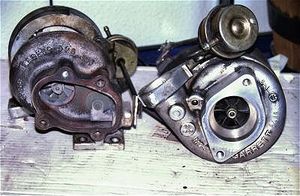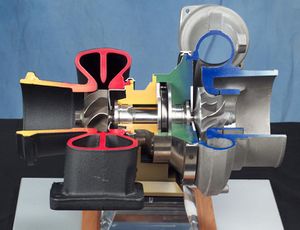Turbocharger
A Turbocharger is a device that, using exhaust gas as a means of propulsion, creates positive pressure in the intake manifold. This drastically improves performance.
Contents
Operation
Turbochargers consist of three basic components:
- The exhaust housing (red) and its turbine.
- The compressor housing (blue) and its impeller.
- The center housing & rotating assembly (CHRA, the yellow-green section in the center).
As exhaust gas flows through the exhaust housing, it spins the turbine before exiting, which in turn spins the impeller in the compressor housing. The impeller then sucks in air (through the opening in the center), expelling it through the outlet on the side of the housing. This air is then fed to the intake manifold of the engine, and into the cylinders. This forces in a greater amount of air than the engine would naturally inhale through the motion of his pistons--thus, defining the difference between a naturally aspirated engine, and one utilizing forced induction. The added air (called boost) creates higher pressure in the combustion chamber, leading to a stronger combustion and greater power output.
On the Z32
Gaskets & Accessories
Parallel Twin Turbocharging
The Z32, in Twin Turbo form, utilizes two turbochargers manufactured by Garrett. They are installed in a parallel twin turbo arrangement. This means that each turbo is fed by (and feeds) three cylinders; one half of the engine. Because each turbocharger only has to provide boost for three cylinders, they can be made much smaller than if used in a single-turbo setup. The smaller size allows them to accelerate (or spool up) much more quickly than one large turbo, providing faster response.
The parallel twin turbo setup is in contrast to a sequential twin turbo setup, such as that utilized by the Toyota Supra. In such a setup, one small turbo is used at the lower speeds, and the system gradually switches to a large turbo for the top-end.
Specifications
Stock Z32 TT turbos are Garrett TB02/22 turbos. They carry the following specifications:
| Compressor |
Turbine | |||||||
| Wheel Trim |
Inducer Diameter |
Exducer Diameter |
Housing |
CFM |
Wheel (Trim) |
Exducer Diameter |
Inducer Diameter |
Flange Style |
| T2 |
40mm |
51mm |
TB22 |
304 (Max) |
T22 (69) |
38.9mm |
47mm |
T25 |
- These turbos use a 270 degree thrust bearings (journal bearings) in the CHRA.
- Water cooling is used for longevity.
- Internal Wastegates are used for compactness.
- M/T cars had turbos with an A/R trim of .63. A/T cars, .54.
- Left and Right turbos are interchangeable, but will require re-clocking and swapping of its associated components (coolant pipes, oil pipes, intake/outlet pipes, wastegate actuator brackets, etc).
Stock turbochargers are known for their quick spool-up, but are limited to around 16 PSI of boost before they become inefficient. Despite this, stock turbochargers have made close to 500 HP (link) on a stock engine.
Compressor Map

Thanks, Vedran M! The Japanese text simply says "Nissan Genuine Parts."
Upgrades
There is a wide variety of turbocharger upgrades available for the Z32 to fit practically every need. A few notable examples are...
- JWT Sport 500s. Modified stock turbos, old tech but still decent.
- JWT Sport 530BBs. Ball-bearing, just slightly larger than stock, but offering VERY quick spool-up and higher top-end.
- Garrett GT 2860 RS (Sport 700s). Ball bearing, much larger and provides boost for upwards of 700 HP.
- Garrett GT 3071 and 3076. The largest turbos that can be fit in a Z without major modification.
Replacement
While the Factory Service Manual details how to replace turbochargers with the engine in the car (EM-38), the general consensus is that it's much easier to remove the motor. The added benefit is that pulling the motor allows the owner to complete many other tasks that are probably a necessity by the time the turbos need to be replaced or upgraded.

